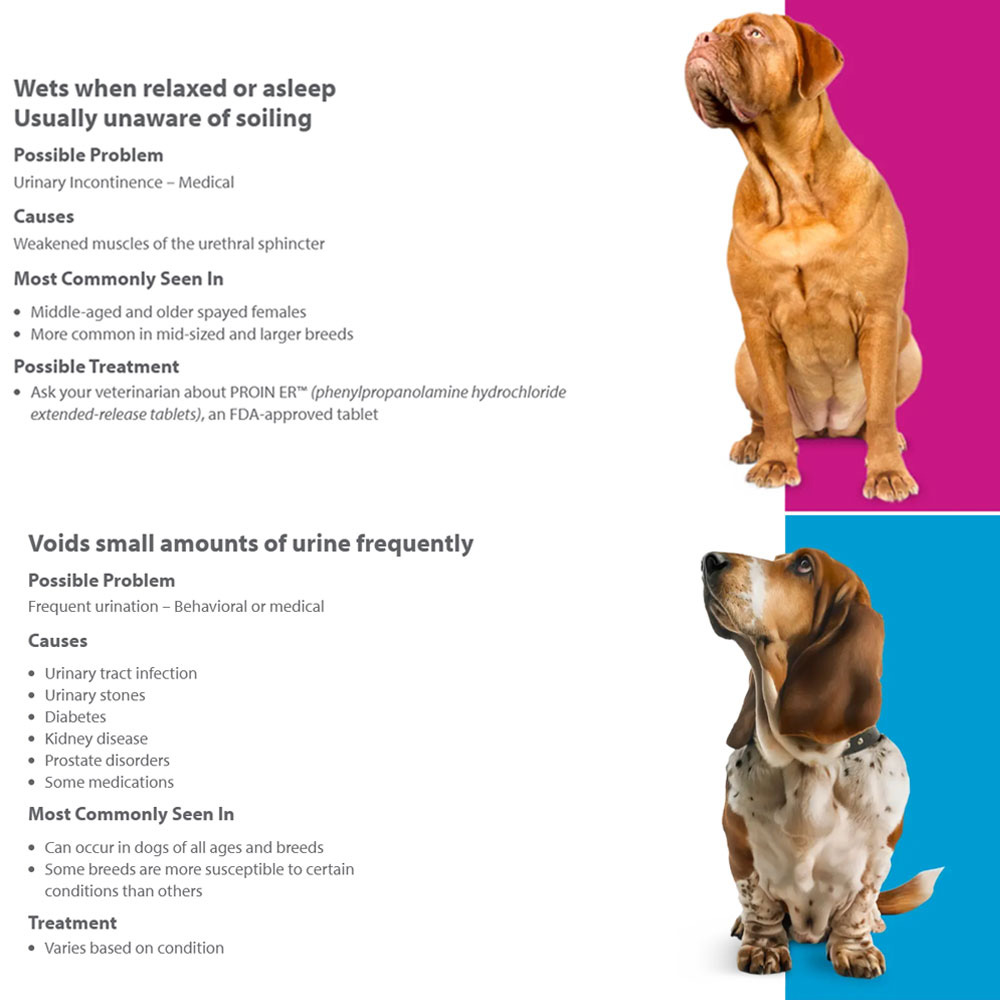

What are the common clinical signs of urinary incontinence in dogs?
- Dripping or leaking urine
- Excessive licking of the genital area
- Red and irritated skin around the genital area
- Needing to to more frequently than normal
- Wetting the bed or sleeping area
- Urinating inappropriately in the house
Fortunately, while frustrating at first, canine urinary incontinence may be controlled with PROIN ER™, a safe and effective FDA-approved once-a-day tablet that works by increasing urethral sphincter tone to help prevent urinary accidents.
Why PROIN ER™
- Convenient – Given with food, a single dose per day simplifies treatment
- Innovative – Patented release technology provides controlled release that ensures steady absorption
- Easy to Administer – Chewable, liver-flavored tablets improve compliance
- Easy to Prescribe – Four dosing strengths based on body weight to provide simplicity
- FDA Approved – FDA approved for control of urinary incontinence due to urethral sphincter hypotonus in dogs
Dosage & Administration:
The recommended dosage is 2 to 4 mg/kg (0.9 to 1.8 mg/lb) of body weight once daily according to Table 1 below. Administer PROIN ER with food (see Clinical Pharmacology). Do not split or crush tablets.
Dogs weighing less than 10 pounds cannot be safely dosed because tablet administration would result in a dose over 4 mg/kg.
| Dose Administrationsa: |
| Body weight in pounds |
PROIN ER |
| 10-20 |
18 mg |
| 21-40 |
38 mg |
| 41-80 |
74 mg |
| 81-125b
| 145 mg |
aBody weight should be rounded to the nearest pound.
bDogs exceedign 125 lbs should receive the appropriate combination of tablets to achieve the recommended dosage.
Dogs may transition from PROIN® Chewable Tablets to PROIN ER without a break in administration. However, do not alternate PROIN ER with PROIN Chewable Tablets because the effectiveness and safety of interchangeable use have not been evaluated.
WARNINGS: Not for human use. Keep out of reach of children. Consult a physician in case of accidental ingestion by humans.
Keep PROIN ER in a secured location out of reach of dogs, cats, and other animals to prevent accidental ingestion or overdose.
PRECAUTIONS: Proin ER may mask signs of incontinence due to urinary tract infection. PROIN ER is not effective in dogs with incontinence due to neurologic disease or malformations.
PROIN ER may cause hypertension; therefore, use with caution in dogs with pre-existing heart disease, hypertension, liver disease, kidney insufficiency, diabetes, glaucoma, and conditions with a predilection for hypertension.
Use with caution in dogs receiving sympathomimetic drugs, tricyclic antidepressants, or monoamine oxidase inhibitors as increased toxicity may result. Use with caution in dogs administered halogenated gaseous anesthetics as this may increase the risk of cardiac arrhythmias.
A laboratory study on human blood revealed that phenyl-propanolamine (PPA) used in conjunction with aspirin may potentiate decreased platelet aggregation.1
PROIN ER may cause increase thirst; therefore, provide dogs with ample fresh water.
The safe use of PROIN ER has not been evaluated in dogs that are intended for breeding, or that are pregnant or lactating.


























